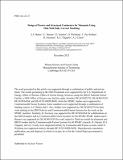| dc.contributor.author | Battey, A.F. | en_US |
| dc.contributor.author | Hansen, C. | en_US |
| dc.contributor.author | Garnier, D. | en_US |
| dc.contributor.author | Weisberg, D. | en_US |
| dc.contributor.author | Paz-Soldan, C. | en_US |
| dc.contributor.author | Sweeney, Ryan | en_US |
| dc.contributor.author | Tinguely, R. Alex | en_US |
| dc.contributor.author | Creely, A.J. | en_US |
| dc.date.accessioned | 2025-03-21T20:24:52Z | |
| dc.date.available | 2025-03-21T20:24:52Z | |
| dc.date.issued | 2023-12 | |
| dc.identifier | 23ja027 | |
| dc.identifier.uri | https://hdl.handle.net/1721.1/158760 | |
| dc.description | Submitted for publication in Nuclear Fusion | |
| dc.description.abstract | A new three-dimensional electromagnetic modeling tool (ThinCurr) has been developed using the existing PSI-Tet finite-element code in support of conducting structure design work for both the SPARC and DIII-D tokamaks. Within this framework a 3D conducting structure model was created for both the SPARC and DIII-D tokamaks in the thin-wall limit. This model includes accurate details of the vacuum vessel and other conducting structural elements with realistic material resistivities. This model was leveraged to support the design of a passive runaway electron mitigation coil (REMC), studying the effect of various design parameters, including coil resistivity, current quench duration, and plasma vertical position, on the effectiveness of the coil. The REMC is a non-axisymmetric coil designed to passively drive large non-axisymmetric fields during the plasma disruption thereby destroying flux surfaces and deconfining RE seed populations. These studies indicate that current designs should apply substantial 3D fields at the plasma surface during future plasma current disruptions as well as highlight the importance of having the REMC conductors away from the machine midplane in order to ensure they are robust to off-normal disruption scenarios. | |
| dc.publisher | IOP | en_US |
| dc.relation.isversionof | doi.org/10.1088/1741-4326/ad0bcf | |
| dc.source | Plasma Science and Fusion Center | en_US |
| dc.title | Design of Passive and Structural Conductors for Tokamaks Using Thin-Wall Eddy Current Modeling | en_US |
| dc.type | Article | en_US |
| dc.contributor.department | Massachusetts Institute of Technology. Plasma Science and Fusion Center | |
| dc.relation.journal | Nuclear Fusion | |
